Analysis of Unilever's Business Environment Report
VerifiedAdded on 2023/03/16
|16
|5016
|93
Report
AI Summary
This report provides a comprehensive analysis of Unilever's business environment, focusing on its organizational structure, size, and scope, and how these elements relate to its business objectives, products, and services. It examines the relationships between various organizational functions, such as human resources, marketing, operations, production, research and development, and finance, evaluating their advantages and disadvantages and their impact on organizational structure. The report also applies the PESTLE model to assess the positive and negative impacts of macro-environmental elements, including political, economic, social, technological, legal, and environmental factors, on Unilever's operations. Furthermore, it utilizes SWOT/TOWS analysis to evaluate Unilever's strengths, weaknesses, opportunities, and threats, and how these analyses influence decision-making processes within the company, drawing conclusions on the company's strategies and performance.
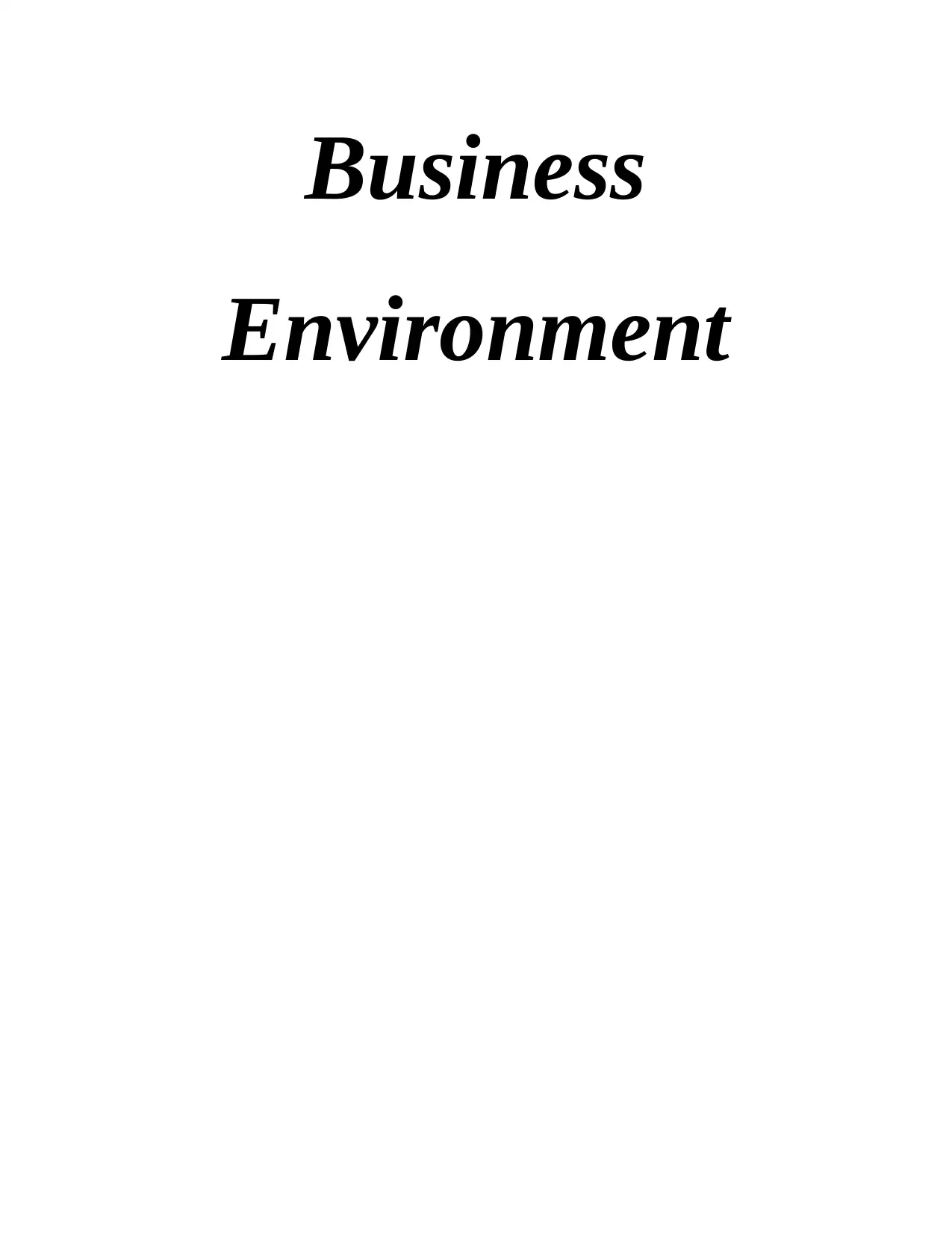
Business
Environment
Environment
Paraphrase This Document
Need a fresh take? Get an instant paraphrase of this document with our AI Paraphraser
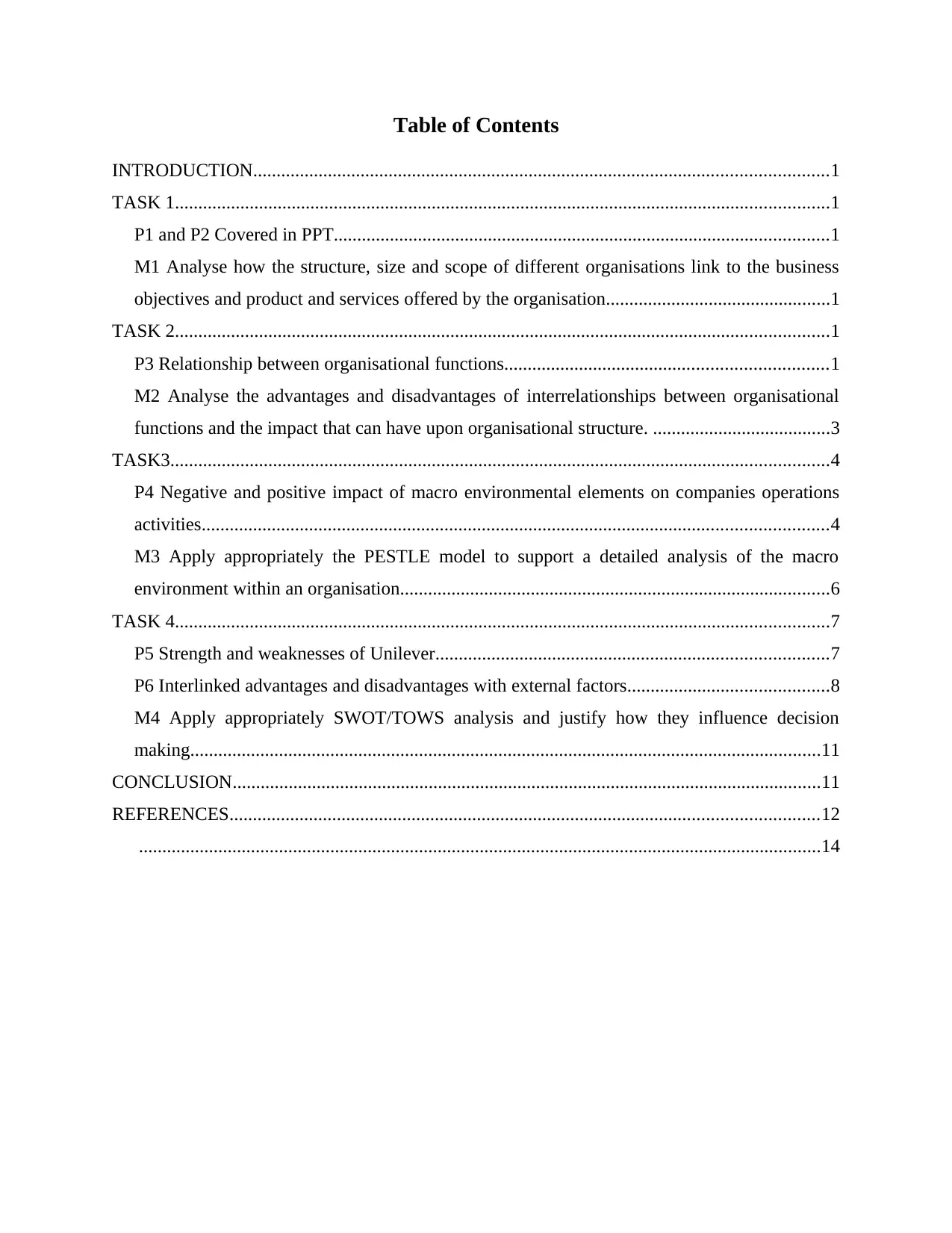
Table of Contents
INTRODUCTION...........................................................................................................................1
TASK 1............................................................................................................................................1
P1 and P2 Covered in PPT..........................................................................................................1
M1 Analyse how the structure, size and scope of different organisations link to the business
objectives and product and services offered by the organisation................................................1
TASK 2............................................................................................................................................1
P3 Relationship between organisational functions.....................................................................1
M2 Analyse the advantages and disadvantages of interrelationships between organisational
functions and the impact that can have upon organisational structure. ......................................3
TASK3.............................................................................................................................................4
P4 Negative and positive impact of macro environmental elements on companies operations
activities......................................................................................................................................4
M3 Apply appropriately the PESTLE model to support a detailed analysis of the macro
environment within an organisation............................................................................................6
TASK 4............................................................................................................................................7
P5 Strength and weaknesses of Unilever....................................................................................7
P6 Interlinked advantages and disadvantages with external factors...........................................8
M4 Apply appropriately SWOT/TOWS analysis and justify how they influence decision
making.......................................................................................................................................11
CONCLUSION..............................................................................................................................11
REFERENCES..............................................................................................................................12
..................................................................................................................................................14
INTRODUCTION...........................................................................................................................1
TASK 1............................................................................................................................................1
P1 and P2 Covered in PPT..........................................................................................................1
M1 Analyse how the structure, size and scope of different organisations link to the business
objectives and product and services offered by the organisation................................................1
TASK 2............................................................................................................................................1
P3 Relationship between organisational functions.....................................................................1
M2 Analyse the advantages and disadvantages of interrelationships between organisational
functions and the impact that can have upon organisational structure. ......................................3
TASK3.............................................................................................................................................4
P4 Negative and positive impact of macro environmental elements on companies operations
activities......................................................................................................................................4
M3 Apply appropriately the PESTLE model to support a detailed analysis of the macro
environment within an organisation............................................................................................6
TASK 4............................................................................................................................................7
P5 Strength and weaknesses of Unilever....................................................................................7
P6 Interlinked advantages and disadvantages with external factors...........................................8
M4 Apply appropriately SWOT/TOWS analysis and justify how they influence decision
making.......................................................................................................................................11
CONCLUSION..............................................................................................................................11
REFERENCES..............................................................................................................................12
..................................................................................................................................................14
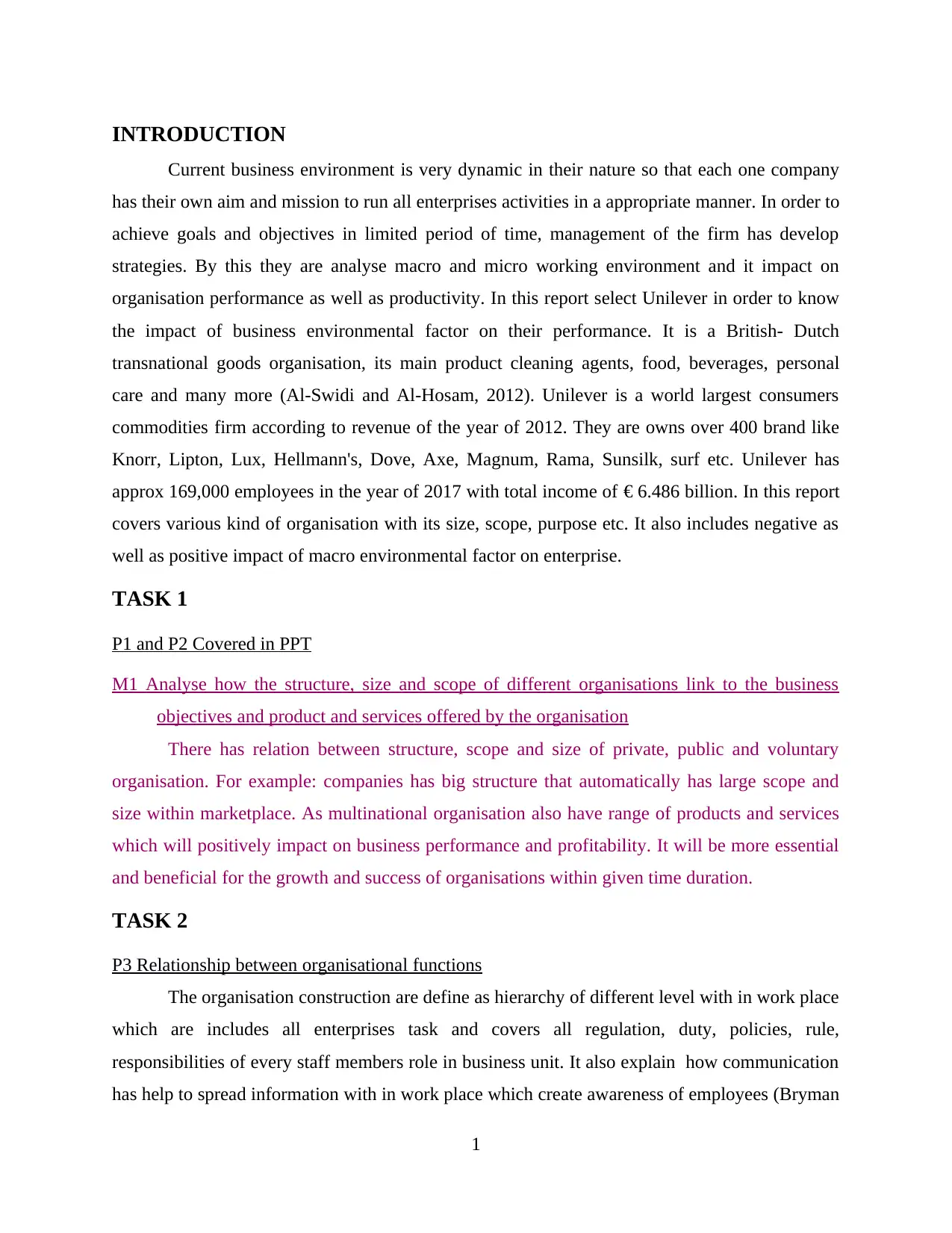
INTRODUCTION
Current business environment is very dynamic in their nature so that each one company
has their own aim and mission to run all enterprises activities in a appropriate manner. In order to
achieve goals and objectives in limited period of time, management of the firm has develop
strategies. By this they are analyse macro and micro working environment and it impact on
organisation performance as well as productivity. In this report select Unilever in order to know
the impact of business environmental factor on their performance. It is a British- Dutch
transnational goods organisation, its main product cleaning agents, food, beverages, personal
care and many more (Al-Swidi and Al-Hosam, 2012). Unilever is a world largest consumers
commodities firm according to revenue of the year of 2012. They are owns over 400 brand like
Knorr, Lipton, Lux, Hellmann's, Dove, Axe, Magnum, Rama, Sunsilk, surf etc. Unilever has
approx 169,000 employees in the year of 2017 with total income of € 6.486 billion. In this report
covers various kind of organisation with its size, scope, purpose etc. It also includes negative as
well as positive impact of macro environmental factor on enterprise.
TASK 1
P1 and P2 Covered in PPT
M1 Analyse how the structure, size and scope of different organisations link to the business
objectives and product and services offered by the organisation
There has relation between structure, scope and size of private, public and voluntary
organisation. For example: companies has big structure that automatically has large scope and
size within marketplace. As multinational organisation also have range of products and services
which will positively impact on business performance and profitability. It will be more essential
and beneficial for the growth and success of organisations within given time duration.
TASK 2
P3 Relationship between organisational functions
The organisation construction are define as hierarchy of different level with in work place
which are includes all enterprises task and covers all regulation, duty, policies, rule,
responsibilities of every staff members role in business unit. It also explain how communication
has help to spread information with in work place which create awareness of employees (Bryman
1
Current business environment is very dynamic in their nature so that each one company
has their own aim and mission to run all enterprises activities in a appropriate manner. In order to
achieve goals and objectives in limited period of time, management of the firm has develop
strategies. By this they are analyse macro and micro working environment and it impact on
organisation performance as well as productivity. In this report select Unilever in order to know
the impact of business environmental factor on their performance. It is a British- Dutch
transnational goods organisation, its main product cleaning agents, food, beverages, personal
care and many more (Al-Swidi and Al-Hosam, 2012). Unilever is a world largest consumers
commodities firm according to revenue of the year of 2012. They are owns over 400 brand like
Knorr, Lipton, Lux, Hellmann's, Dove, Axe, Magnum, Rama, Sunsilk, surf etc. Unilever has
approx 169,000 employees in the year of 2017 with total income of € 6.486 billion. In this report
covers various kind of organisation with its size, scope, purpose etc. It also includes negative as
well as positive impact of macro environmental factor on enterprise.
TASK 1
P1 and P2 Covered in PPT
M1 Analyse how the structure, size and scope of different organisations link to the business
objectives and product and services offered by the organisation
There has relation between structure, scope and size of private, public and voluntary
organisation. For example: companies has big structure that automatically has large scope and
size within marketplace. As multinational organisation also have range of products and services
which will positively impact on business performance and profitability. It will be more essential
and beneficial for the growth and success of organisations within given time duration.
TASK 2
P3 Relationship between organisational functions
The organisation construction are define as hierarchy of different level with in work place
which are includes all enterprises task and covers all regulation, duty, policies, rule,
responsibilities of every staff members role in business unit. It also explain how communication
has help to spread information with in work place which create awareness of employees (Bryman
1
⊘ This is a preview!⊘
Do you want full access?
Subscribe today to unlock all pages.

Trusted by 1+ million students worldwide
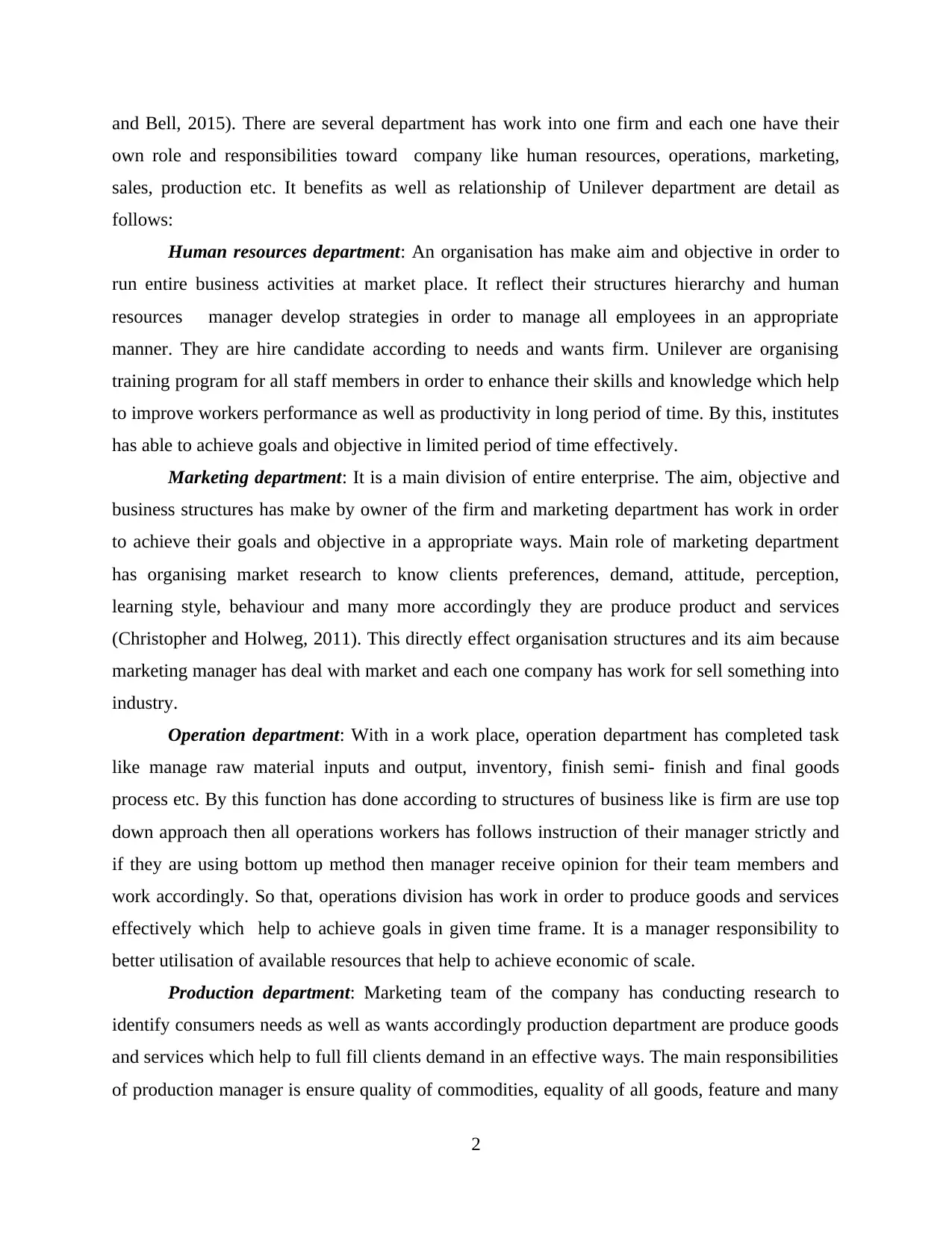
and Bell, 2015). There are several department has work into one firm and each one have their
own role and responsibilities toward company like human resources, operations, marketing,
sales, production etc. It benefits as well as relationship of Unilever department are detail as
follows:
Human resources department: An organisation has make aim and objective in order to
run entire business activities at market place. It reflect their structures hierarchy and human
resources manager develop strategies in order to manage all employees in an appropriate
manner. They are hire candidate according to needs and wants firm. Unilever are organising
training program for all staff members in order to enhance their skills and knowledge which help
to improve workers performance as well as productivity in long period of time. By this, institutes
has able to achieve goals and objective in limited period of time effectively.
Marketing department: It is a main division of entire enterprise. The aim, objective and
business structures has make by owner of the firm and marketing department has work in order
to achieve their goals and objective in a appropriate ways. Main role of marketing department
has organising market research to know clients preferences, demand, attitude, perception,
learning style, behaviour and many more accordingly they are produce product and services
(Christopher and Holweg, 2011). This directly effect organisation structures and its aim because
marketing manager has deal with market and each one company has work for sell something into
industry.
Operation department: With in a work place, operation department has completed task
like manage raw material inputs and output, inventory, finish semi- finish and final goods
process etc. By this function has done according to structures of business like is firm are use top
down approach then all operations workers has follows instruction of their manager strictly and
if they are using bottom up method then manager receive opinion for their team members and
work accordingly. So that, operations division has work in order to produce goods and services
effectively which help to achieve goals in given time frame. It is a manager responsibility to
better utilisation of available resources that help to achieve economic of scale.
Production department: Marketing team of the company has conducting research to
identify consumers needs as well as wants accordingly production department are produce goods
and services which help to full fill clients demand in an effective ways. The main responsibilities
of production manager is ensure quality of commodities, equality of all goods, feature and many
2
own role and responsibilities toward company like human resources, operations, marketing,
sales, production etc. It benefits as well as relationship of Unilever department are detail as
follows:
Human resources department: An organisation has make aim and objective in order to
run entire business activities at market place. It reflect their structures hierarchy and human
resources manager develop strategies in order to manage all employees in an appropriate
manner. They are hire candidate according to needs and wants firm. Unilever are organising
training program for all staff members in order to enhance their skills and knowledge which help
to improve workers performance as well as productivity in long period of time. By this, institutes
has able to achieve goals and objective in limited period of time effectively.
Marketing department: It is a main division of entire enterprise. The aim, objective and
business structures has make by owner of the firm and marketing department has work in order
to achieve their goals and objective in a appropriate ways. Main role of marketing department
has organising market research to know clients preferences, demand, attitude, perception,
learning style, behaviour and many more accordingly they are produce product and services
(Christopher and Holweg, 2011). This directly effect organisation structures and its aim because
marketing manager has deal with market and each one company has work for sell something into
industry.
Operation department: With in a work place, operation department has completed task
like manage raw material inputs and output, inventory, finish semi- finish and final goods
process etc. By this function has done according to structures of business like is firm are use top
down approach then all operations workers has follows instruction of their manager strictly and
if they are using bottom up method then manager receive opinion for their team members and
work accordingly. So that, operations division has work in order to produce goods and services
effectively which help to achieve goals in given time frame. It is a manager responsibility to
better utilisation of available resources that help to achieve economic of scale.
Production department: Marketing team of the company has conducting research to
identify consumers needs as well as wants accordingly production department are produce goods
and services which help to full fill clients demand in an effective ways. The main responsibilities
of production manager is ensure quality of commodities, equality of all goods, feature and many
2
Paraphrase This Document
Need a fresh take? Get an instant paraphrase of this document with our AI Paraphraser
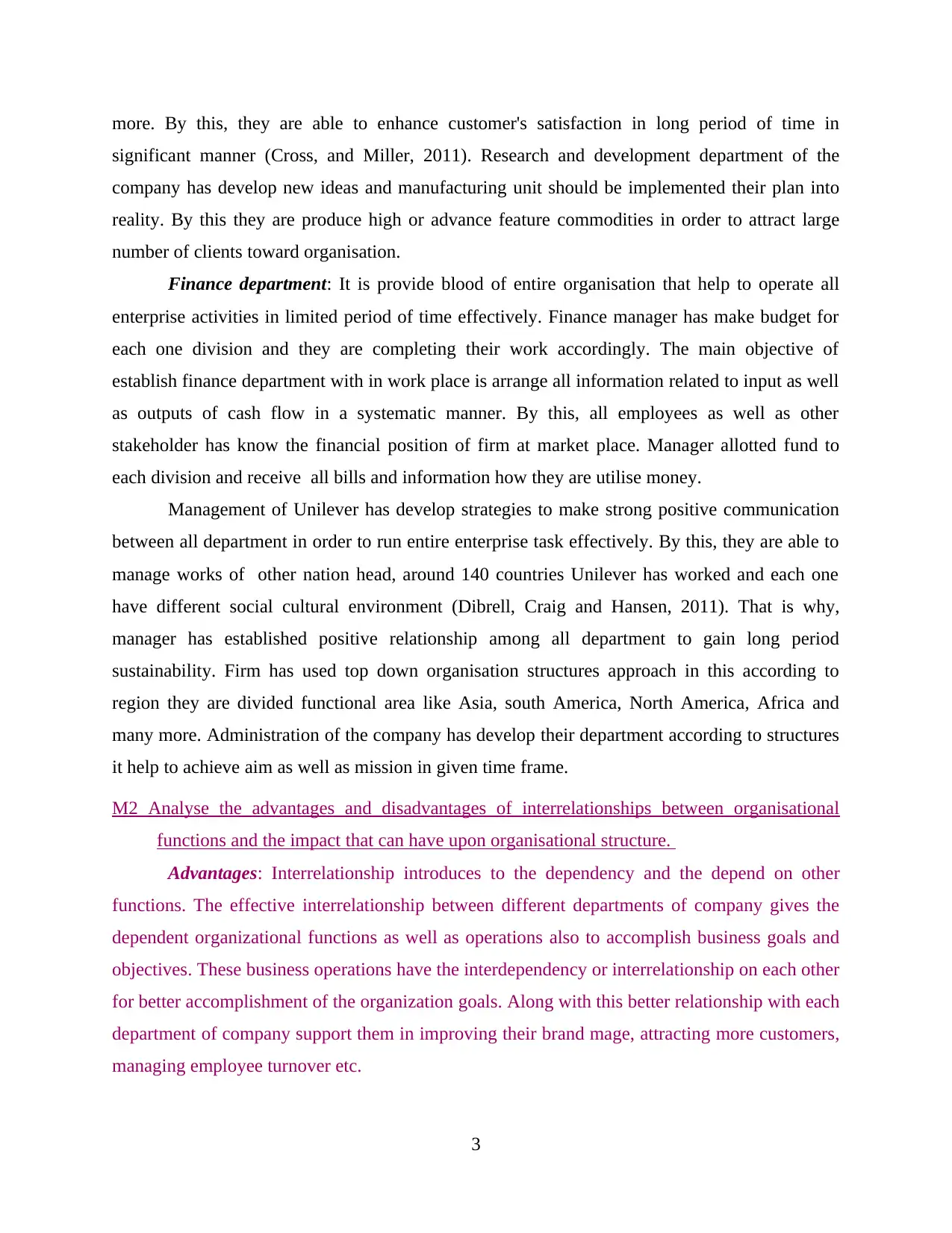
more. By this, they are able to enhance customer's satisfaction in long period of time in
significant manner (Cross, and Miller, 2011). Research and development department of the
company has develop new ideas and manufacturing unit should be implemented their plan into
reality. By this they are produce high or advance feature commodities in order to attract large
number of clients toward organisation.
Finance department: It is provide blood of entire organisation that help to operate all
enterprise activities in limited period of time effectively. Finance manager has make budget for
each one division and they are completing their work accordingly. The main objective of
establish finance department with in work place is arrange all information related to input as well
as outputs of cash flow in a systematic manner. By this, all employees as well as other
stakeholder has know the financial position of firm at market place. Manager allotted fund to
each division and receive all bills and information how they are utilise money.
Management of Unilever has develop strategies to make strong positive communication
between all department in order to run entire enterprise task effectively. By this, they are able to
manage works of other nation head, around 140 countries Unilever has worked and each one
have different social cultural environment (Dibrell, Craig and Hansen, 2011). That is why,
manager has established positive relationship among all department to gain long period
sustainability. Firm has used top down organisation structures approach in this according to
region they are divided functional area like Asia, south America, North America, Africa and
many more. Administration of the company has develop their department according to structures
it help to achieve aim as well as mission in given time frame.
M2 Analyse the advantages and disadvantages of interrelationships between organisational
functions and the impact that can have upon organisational structure.
Advantages: Interrelationship introduces to the dependency and the depend on other
functions. The effective interrelationship between different departments of company gives the
dependent organizational functions as well as operations also to accomplish business goals and
objectives. These business operations have the interdependency or interrelationship on each other
for better accomplishment of the organization goals. Along with this better relationship with each
department of company support them in improving their brand mage, attracting more customers,
managing employee turnover etc.
3
significant manner (Cross, and Miller, 2011). Research and development department of the
company has develop new ideas and manufacturing unit should be implemented their plan into
reality. By this they are produce high or advance feature commodities in order to attract large
number of clients toward organisation.
Finance department: It is provide blood of entire organisation that help to operate all
enterprise activities in limited period of time effectively. Finance manager has make budget for
each one division and they are completing their work accordingly. The main objective of
establish finance department with in work place is arrange all information related to input as well
as outputs of cash flow in a systematic manner. By this, all employees as well as other
stakeholder has know the financial position of firm at market place. Manager allotted fund to
each division and receive all bills and information how they are utilise money.
Management of Unilever has develop strategies to make strong positive communication
between all department in order to run entire enterprise task effectively. By this, they are able to
manage works of other nation head, around 140 countries Unilever has worked and each one
have different social cultural environment (Dibrell, Craig and Hansen, 2011). That is why,
manager has established positive relationship among all department to gain long period
sustainability. Firm has used top down organisation structures approach in this according to
region they are divided functional area like Asia, south America, North America, Africa and
many more. Administration of the company has develop their department according to structures
it help to achieve aim as well as mission in given time frame.
M2 Analyse the advantages and disadvantages of interrelationships between organisational
functions and the impact that can have upon organisational structure.
Advantages: Interrelationship introduces to the dependency and the depend on other
functions. The effective interrelationship between different departments of company gives the
dependent organizational functions as well as operations also to accomplish business goals and
objectives. These business operations have the interdependency or interrelationship on each other
for better accomplishment of the organization goals. Along with this better relationship with each
department of company support them in improving their brand mage, attracting more customers,
managing employee turnover etc.
3
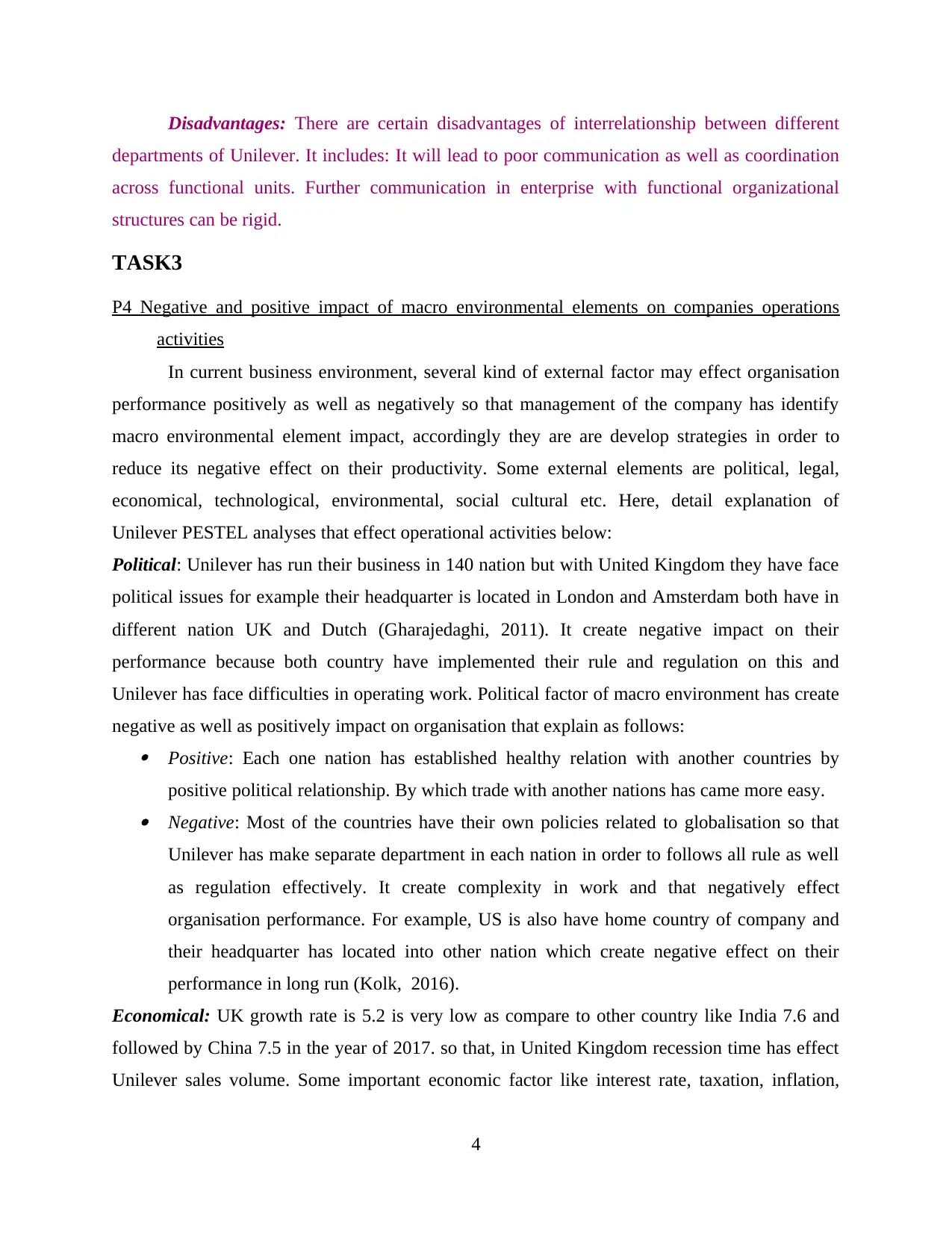
Disadvantages: There are certain disadvantages of interrelationship between different
departments of Unilever. It includes: It will lead to poor communication as well as coordination
across functional units. Further communication in enterprise with functional organizational
structures can be rigid.
TASK3
P4 Negative and positive impact of macro environmental elements on companies operations
activities
In current business environment, several kind of external factor may effect organisation
performance positively as well as negatively so that management of the company has identify
macro environmental element impact, accordingly they are are develop strategies in order to
reduce its negative effect on their productivity. Some external elements are political, legal,
economical, technological, environmental, social cultural etc. Here, detail explanation of
Unilever PESTEL analyses that effect operational activities below:
Political: Unilever has run their business in 140 nation but with United Kingdom they have face
political issues for example their headquarter is located in London and Amsterdam both have in
different nation UK and Dutch (Gharajedaghi, 2011). It create negative impact on their
performance because both country have implemented their rule and regulation on this and
Unilever has face difficulties in operating work. Political factor of macro environment has create
negative as well as positively impact on organisation that explain as follows: Positive: Each one nation has established healthy relation with another countries by
positive political relationship. By which trade with another nations has came more easy. Negative: Most of the countries have their own policies related to globalisation so that
Unilever has make separate department in each nation in order to follows all rule as well
as regulation effectively. It create complexity in work and that negatively effect
organisation performance. For example, US is also have home country of company and
their headquarter has located into other nation which create negative effect on their
performance in long run (Kolk, 2016).
Economical: UK growth rate is 5.2 is very low as compare to other country like India 7.6 and
followed by China 7.5 in the year of 2017. so that, in United Kingdom recession time has effect
Unilever sales volume. Some important economic factor like interest rate, taxation, inflation,
4
departments of Unilever. It includes: It will lead to poor communication as well as coordination
across functional units. Further communication in enterprise with functional organizational
structures can be rigid.
TASK3
P4 Negative and positive impact of macro environmental elements on companies operations
activities
In current business environment, several kind of external factor may effect organisation
performance positively as well as negatively so that management of the company has identify
macro environmental element impact, accordingly they are are develop strategies in order to
reduce its negative effect on their productivity. Some external elements are political, legal,
economical, technological, environmental, social cultural etc. Here, detail explanation of
Unilever PESTEL analyses that effect operational activities below:
Political: Unilever has run their business in 140 nation but with United Kingdom they have face
political issues for example their headquarter is located in London and Amsterdam both have in
different nation UK and Dutch (Gharajedaghi, 2011). It create negative impact on their
performance because both country have implemented their rule and regulation on this and
Unilever has face difficulties in operating work. Political factor of macro environment has create
negative as well as positively impact on organisation that explain as follows: Positive: Each one nation has established healthy relation with another countries by
positive political relationship. By which trade with another nations has came more easy. Negative: Most of the countries have their own policies related to globalisation so that
Unilever has make separate department in each nation in order to follows all rule as well
as regulation effectively. It create complexity in work and that negatively effect
organisation performance. For example, US is also have home country of company and
their headquarter has located into other nation which create negative effect on their
performance in long run (Kolk, 2016).
Economical: UK growth rate is 5.2 is very low as compare to other country like India 7.6 and
followed by China 7.5 in the year of 2017. so that, in United Kingdom recession time has effect
Unilever sales volume. Some important economic factor like interest rate, taxation, inflation,
4
⊘ This is a preview!⊘
Do you want full access?
Subscribe today to unlock all pages.

Trusted by 1+ million students worldwide
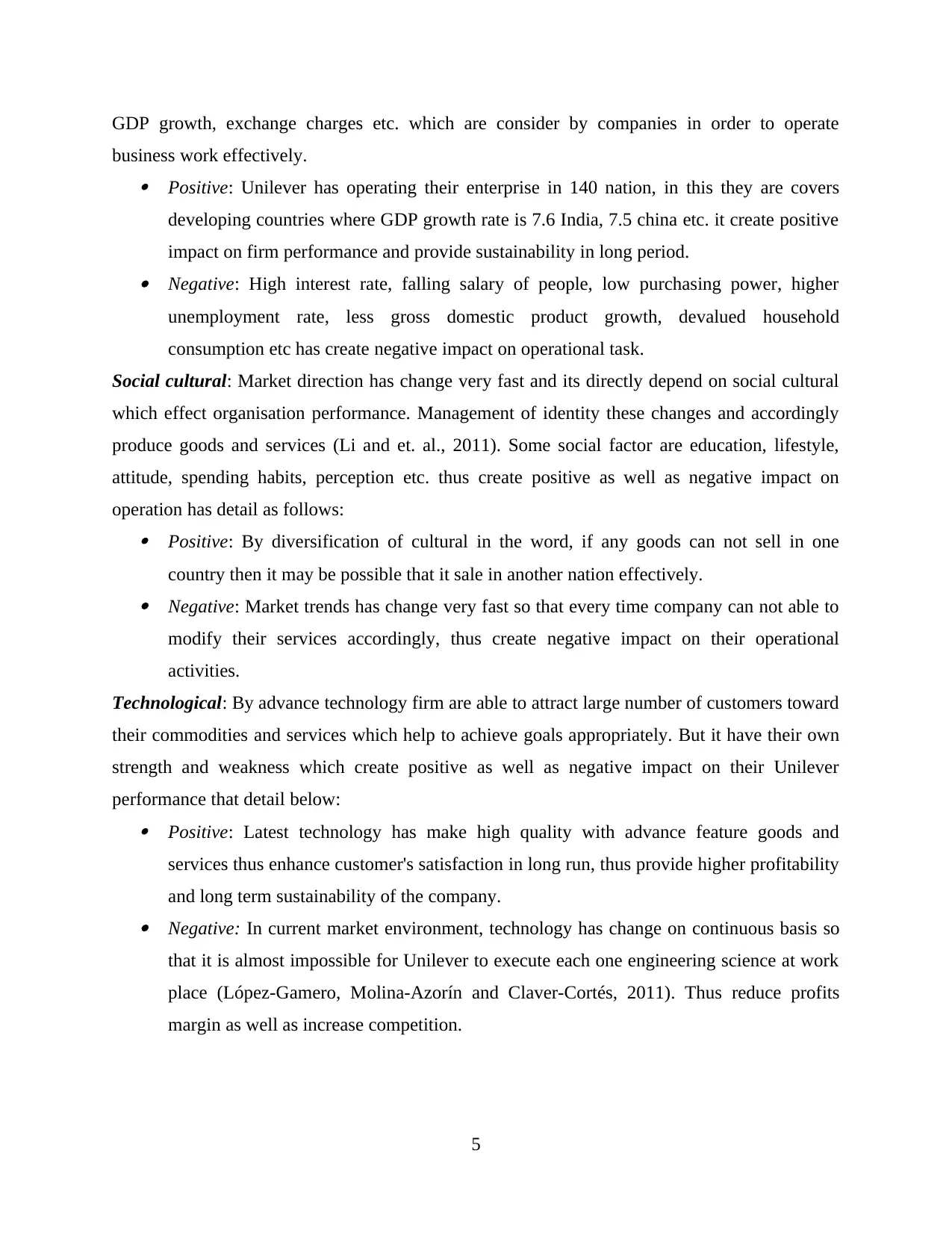
GDP growth, exchange charges etc. which are consider by companies in order to operate
business work effectively. Positive: Unilever has operating their enterprise in 140 nation, in this they are covers
developing countries where GDP growth rate is 7.6 India, 7.5 china etc. it create positive
impact on firm performance and provide sustainability in long period. Negative: High interest rate, falling salary of people, low purchasing power, higher
unemployment rate, less gross domestic product growth, devalued household
consumption etc has create negative impact on operational task.
Social cultural: Market direction has change very fast and its directly depend on social cultural
which effect organisation performance. Management of identity these changes and accordingly
produce goods and services (Li and et. al., 2011). Some social factor are education, lifestyle,
attitude, spending habits, perception etc. thus create positive as well as negative impact on
operation has detail as follows: Positive: By diversification of cultural in the word, if any goods can not sell in one
country then it may be possible that it sale in another nation effectively. Negative: Market trends has change very fast so that every time company can not able to
modify their services accordingly, thus create negative impact on their operational
activities.
Technological: By advance technology firm are able to attract large number of customers toward
their commodities and services which help to achieve goals appropriately. But it have their own
strength and weakness which create positive as well as negative impact on their Unilever
performance that detail below: Positive: Latest technology has make high quality with advance feature goods and
services thus enhance customer's satisfaction in long run, thus provide higher profitability
and long term sustainability of the company. Negative: In current market environment, technology has change on continuous basis so
that it is almost impossible for Unilever to execute each one engineering science at work
place (López-Gamero, Molina-Azorín and Claver-Cortés, 2011). Thus reduce profits
margin as well as increase competition.
5
business work effectively. Positive: Unilever has operating their enterprise in 140 nation, in this they are covers
developing countries where GDP growth rate is 7.6 India, 7.5 china etc. it create positive
impact on firm performance and provide sustainability in long period. Negative: High interest rate, falling salary of people, low purchasing power, higher
unemployment rate, less gross domestic product growth, devalued household
consumption etc has create negative impact on operational task.
Social cultural: Market direction has change very fast and its directly depend on social cultural
which effect organisation performance. Management of identity these changes and accordingly
produce goods and services (Li and et. al., 2011). Some social factor are education, lifestyle,
attitude, spending habits, perception etc. thus create positive as well as negative impact on
operation has detail as follows: Positive: By diversification of cultural in the word, if any goods can not sell in one
country then it may be possible that it sale in another nation effectively. Negative: Market trends has change very fast so that every time company can not able to
modify their services accordingly, thus create negative impact on their operational
activities.
Technological: By advance technology firm are able to attract large number of customers toward
their commodities and services which help to achieve goals appropriately. But it have their own
strength and weakness which create positive as well as negative impact on their Unilever
performance that detail below: Positive: Latest technology has make high quality with advance feature goods and
services thus enhance customer's satisfaction in long run, thus provide higher profitability
and long term sustainability of the company. Negative: In current market environment, technology has change on continuous basis so
that it is almost impossible for Unilever to execute each one engineering science at work
place (López-Gamero, Molina-Azorín and Claver-Cortés, 2011). Thus reduce profits
margin as well as increase competition.
5
Paraphrase This Document
Need a fresh take? Get an instant paraphrase of this document with our AI Paraphraser
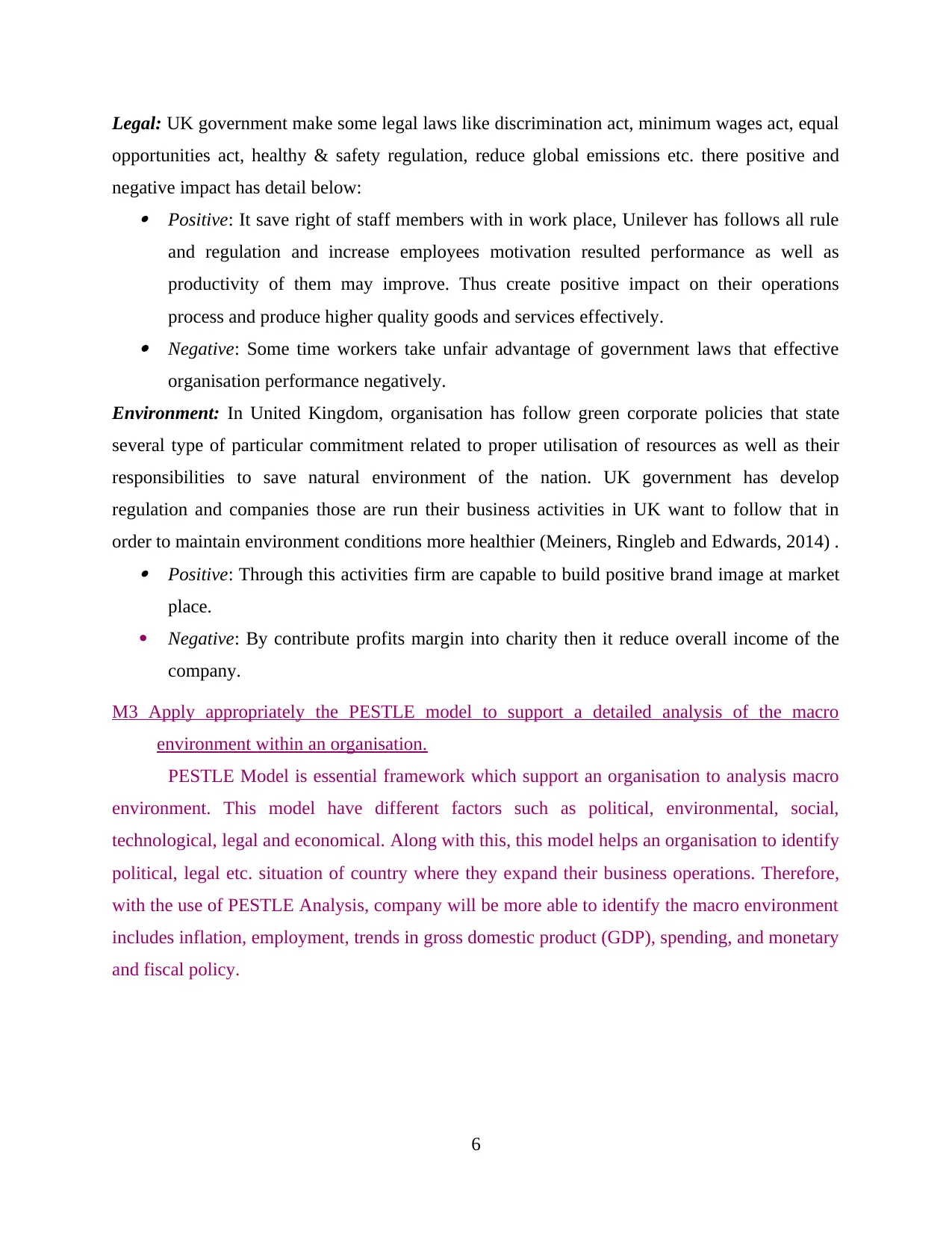
Legal: UK government make some legal laws like discrimination act, minimum wages act, equal
opportunities act, healthy & safety regulation, reduce global emissions etc. there positive and
negative impact has detail below: Positive: It save right of staff members with in work place, Unilever has follows all rule
and regulation and increase employees motivation resulted performance as well as
productivity of them may improve. Thus create positive impact on their operations
process and produce higher quality goods and services effectively. Negative: Some time workers take unfair advantage of government laws that effective
organisation performance negatively.
Environment: In United Kingdom, organisation has follow green corporate policies that state
several type of particular commitment related to proper utilisation of resources as well as their
responsibilities to save natural environment of the nation. UK government has develop
regulation and companies those are run their business activities in UK want to follow that in
order to maintain environment conditions more healthier (Meiners, Ringleb and Edwards, 2014) . Positive: Through this activities firm are capable to build positive brand image at market
place.
Negative: By contribute profits margin into charity then it reduce overall income of the
company.
M3 Apply appropriately the PESTLE model to support a detailed analysis of the macro
environment within an organisation.
PESTLE Model is essential framework which support an organisation to analysis macro
environment. This model have different factors such as political, environmental, social,
technological, legal and economical. Along with this, this model helps an organisation to identify
political, legal etc. situation of country where they expand their business operations. Therefore,
with the use of PESTLE Analysis, company will be more able to identify the macro environment
includes inflation, employment, trends in gross domestic product (GDP), spending, and monetary
and fiscal policy.
6
opportunities act, healthy & safety regulation, reduce global emissions etc. there positive and
negative impact has detail below: Positive: It save right of staff members with in work place, Unilever has follows all rule
and regulation and increase employees motivation resulted performance as well as
productivity of them may improve. Thus create positive impact on their operations
process and produce higher quality goods and services effectively. Negative: Some time workers take unfair advantage of government laws that effective
organisation performance negatively.
Environment: In United Kingdom, organisation has follow green corporate policies that state
several type of particular commitment related to proper utilisation of resources as well as their
responsibilities to save natural environment of the nation. UK government has develop
regulation and companies those are run their business activities in UK want to follow that in
order to maintain environment conditions more healthier (Meiners, Ringleb and Edwards, 2014) . Positive: Through this activities firm are capable to build positive brand image at market
place.
Negative: By contribute profits margin into charity then it reduce overall income of the
company.
M3 Apply appropriately the PESTLE model to support a detailed analysis of the macro
environment within an organisation.
PESTLE Model is essential framework which support an organisation to analysis macro
environment. This model have different factors such as political, environmental, social,
technological, legal and economical. Along with this, this model helps an organisation to identify
political, legal etc. situation of country where they expand their business operations. Therefore,
with the use of PESTLE Analysis, company will be more able to identify the macro environment
includes inflation, employment, trends in gross domestic product (GDP), spending, and monetary
and fiscal policy.
6
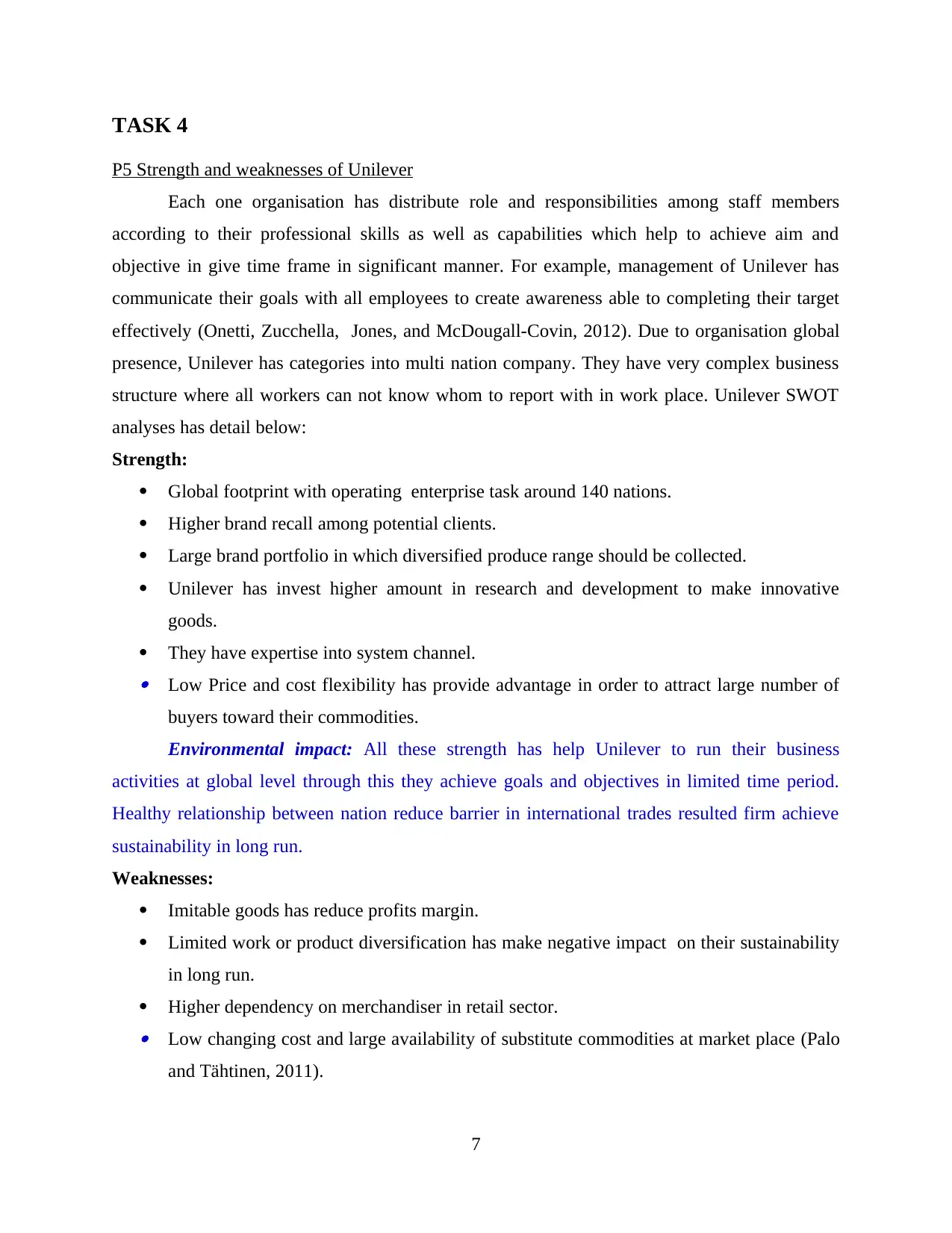
TASK 4
P5 Strength and weaknesses of Unilever
Each one organisation has distribute role and responsibilities among staff members
according to their professional skills as well as capabilities which help to achieve aim and
objective in give time frame in significant manner. For example, management of Unilever has
communicate their goals with all employees to create awareness able to completing their target
effectively (Onetti, Zucchella, Jones, and McDougall-Covin, 2012). Due to organisation global
presence, Unilever has categories into multi nation company. They have very complex business
structure where all workers can not know whom to report with in work place. Unilever SWOT
analyses has detail below:
Strength:
Global footprint with operating enterprise task around 140 nations.
Higher brand recall among potential clients.
Large brand portfolio in which diversified produce range should be collected.
Unilever has invest higher amount in research and development to make innovative
goods.
They have expertise into system channel. Low Price and cost flexibility has provide advantage in order to attract large number of
buyers toward their commodities.
Environmental impact: All these strength has help Unilever to run their business
activities at global level through this they achieve goals and objectives in limited time period.
Healthy relationship between nation reduce barrier in international trades resulted firm achieve
sustainability in long run.
Weaknesses:
Imitable goods has reduce profits margin.
Limited work or product diversification has make negative impact on their sustainability
in long run.
Higher dependency on merchandiser in retail sector. Low changing cost and large availability of substitute commodities at market place (Palo
and Tähtinen, 2011).
7
P5 Strength and weaknesses of Unilever
Each one organisation has distribute role and responsibilities among staff members
according to their professional skills as well as capabilities which help to achieve aim and
objective in give time frame in significant manner. For example, management of Unilever has
communicate their goals with all employees to create awareness able to completing their target
effectively (Onetti, Zucchella, Jones, and McDougall-Covin, 2012). Due to organisation global
presence, Unilever has categories into multi nation company. They have very complex business
structure where all workers can not know whom to report with in work place. Unilever SWOT
analyses has detail below:
Strength:
Global footprint with operating enterprise task around 140 nations.
Higher brand recall among potential clients.
Large brand portfolio in which diversified produce range should be collected.
Unilever has invest higher amount in research and development to make innovative
goods.
They have expertise into system channel. Low Price and cost flexibility has provide advantage in order to attract large number of
buyers toward their commodities.
Environmental impact: All these strength has help Unilever to run their business
activities at global level through this they achieve goals and objectives in limited time period.
Healthy relationship between nation reduce barrier in international trades resulted firm achieve
sustainability in long run.
Weaknesses:
Imitable goods has reduce profits margin.
Limited work or product diversification has make negative impact on their sustainability
in long run.
Higher dependency on merchandiser in retail sector. Low changing cost and large availability of substitute commodities at market place (Palo
and Tähtinen, 2011).
7
⊘ This is a preview!⊘
Do you want full access?
Subscribe today to unlock all pages.

Trusted by 1+ million students worldwide
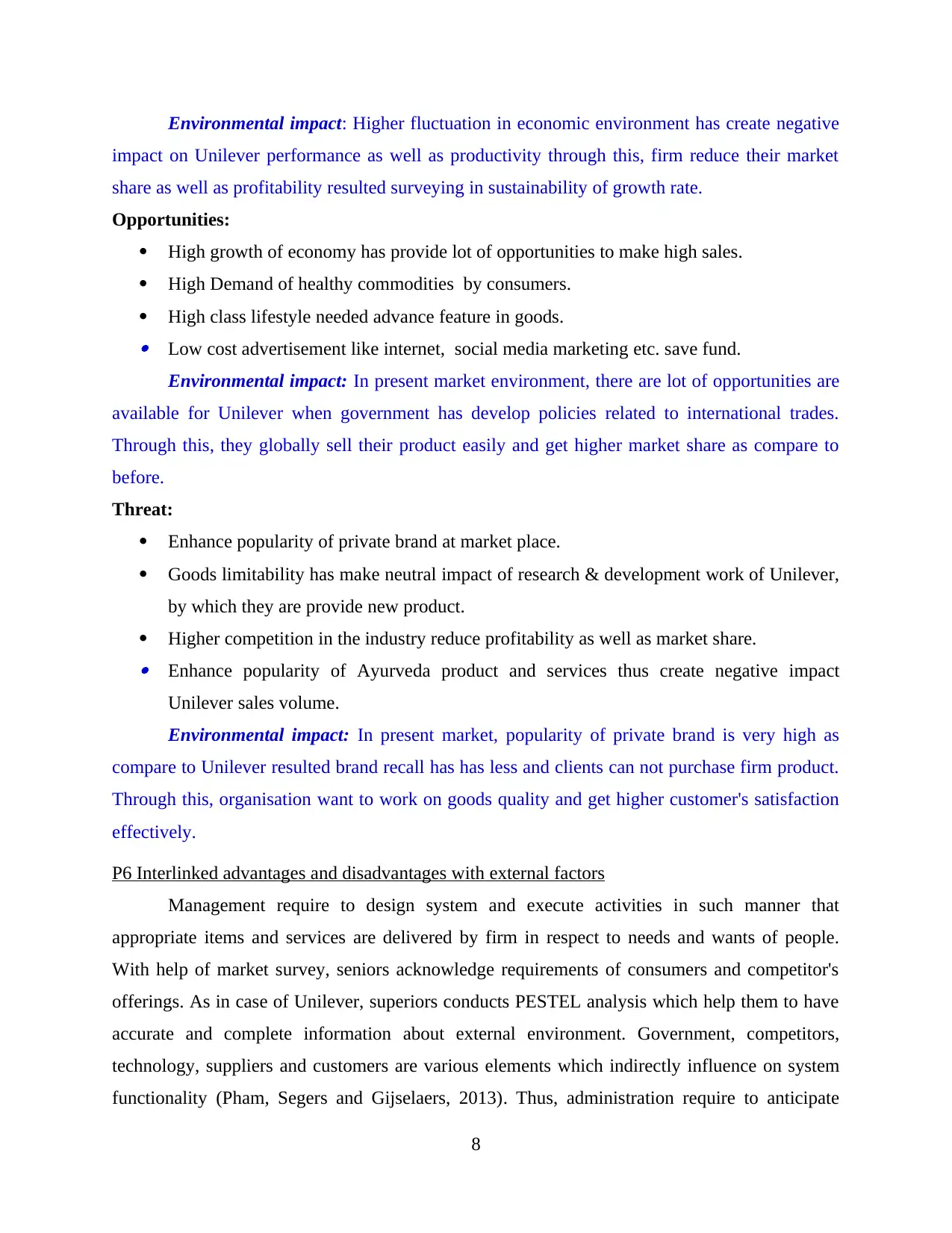
Environmental impact: Higher fluctuation in economic environment has create negative
impact on Unilever performance as well as productivity through this, firm reduce their market
share as well as profitability resulted surveying in sustainability of growth rate.
Opportunities:
High growth of economy has provide lot of opportunities to make high sales.
High Demand of healthy commodities by consumers.
High class lifestyle needed advance feature in goods. Low cost advertisement like internet, social media marketing etc. save fund.
Environmental impact: In present market environment, there are lot of opportunities are
available for Unilever when government has develop policies related to international trades.
Through this, they globally sell their product easily and get higher market share as compare to
before.
Threat:
Enhance popularity of private brand at market place.
Goods limitability has make neutral impact of research & development work of Unilever,
by which they are provide new product.
Higher competition in the industry reduce profitability as well as market share. Enhance popularity of Ayurveda product and services thus create negative impact
Unilever sales volume.
Environmental impact: In present market, popularity of private brand is very high as
compare to Unilever resulted brand recall has has less and clients can not purchase firm product.
Through this, organisation want to work on goods quality and get higher customer's satisfaction
effectively.
P6 Interlinked advantages and disadvantages with external factors
Management require to design system and execute activities in such manner that
appropriate items and services are delivered by firm in respect to needs and wants of people.
With help of market survey, seniors acknowledge requirements of consumers and competitor's
offerings. As in case of Unilever, superiors conducts PESTEL analysis which help them to have
accurate and complete information about external environment. Government, competitors,
technology, suppliers and customers are various elements which indirectly influence on system
functionality (Pham, Segers and Gijselaers, 2013). Thus, administration require to anticipate
8
impact on Unilever performance as well as productivity through this, firm reduce their market
share as well as profitability resulted surveying in sustainability of growth rate.
Opportunities:
High growth of economy has provide lot of opportunities to make high sales.
High Demand of healthy commodities by consumers.
High class lifestyle needed advance feature in goods. Low cost advertisement like internet, social media marketing etc. save fund.
Environmental impact: In present market environment, there are lot of opportunities are
available for Unilever when government has develop policies related to international trades.
Through this, they globally sell their product easily and get higher market share as compare to
before.
Threat:
Enhance popularity of private brand at market place.
Goods limitability has make neutral impact of research & development work of Unilever,
by which they are provide new product.
Higher competition in the industry reduce profitability as well as market share. Enhance popularity of Ayurveda product and services thus create negative impact
Unilever sales volume.
Environmental impact: In present market, popularity of private brand is very high as
compare to Unilever resulted brand recall has has less and clients can not purchase firm product.
Through this, organisation want to work on goods quality and get higher customer's satisfaction
effectively.
P6 Interlinked advantages and disadvantages with external factors
Management require to design system and execute activities in such manner that
appropriate items and services are delivered by firm in respect to needs and wants of people.
With help of market survey, seniors acknowledge requirements of consumers and competitor's
offerings. As in case of Unilever, superiors conducts PESTEL analysis which help them to have
accurate and complete information about external environment. Government, competitors,
technology, suppliers and customers are various elements which indirectly influence on system
functionality (Pham, Segers and Gijselaers, 2013). Thus, administration require to anticipate
8
Paraphrase This Document
Need a fresh take? Get an instant paraphrase of this document with our AI Paraphraser
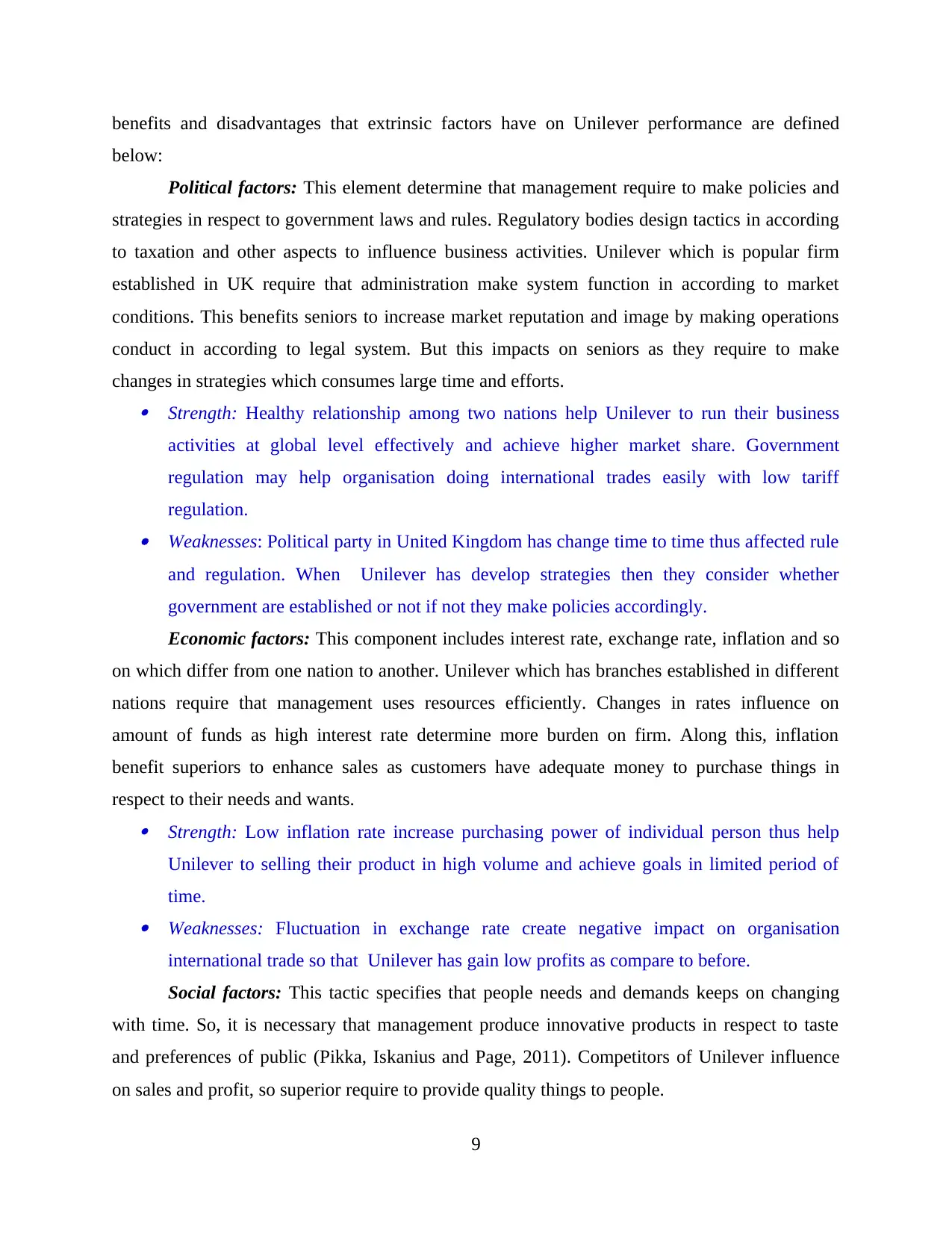
benefits and disadvantages that extrinsic factors have on Unilever performance are defined
below:
Political factors: This element determine that management require to make policies and
strategies in respect to government laws and rules. Regulatory bodies design tactics in according
to taxation and other aspects to influence business activities. Unilever which is popular firm
established in UK require that administration make system function in according to market
conditions. This benefits seniors to increase market reputation and image by making operations
conduct in according to legal system. But this impacts on seniors as they require to make
changes in strategies which consumes large time and efforts. Strength: Healthy relationship among two nations help Unilever to run their business
activities at global level effectively and achieve higher market share. Government
regulation may help organisation doing international trades easily with low tariff
regulation. Weaknesses: Political party in United Kingdom has change time to time thus affected rule
and regulation. When Unilever has develop strategies then they consider whether
government are established or not if not they make policies accordingly.
Economic factors: This component includes interest rate, exchange rate, inflation and so
on which differ from one nation to another. Unilever which has branches established in different
nations require that management uses resources efficiently. Changes in rates influence on
amount of funds as high interest rate determine more burden on firm. Along this, inflation
benefit superiors to enhance sales as customers have adequate money to purchase things in
respect to their needs and wants. Strength: Low inflation rate increase purchasing power of individual person thus help
Unilever to selling their product in high volume and achieve goals in limited period of
time. Weaknesses: Fluctuation in exchange rate create negative impact on organisation
international trade so that Unilever has gain low profits as compare to before.
Social factors: This tactic specifies that people needs and demands keeps on changing
with time. So, it is necessary that management produce innovative products in respect to taste
and preferences of public (Pikka, Iskanius and Page, 2011). Competitors of Unilever influence
on sales and profit, so superior require to provide quality things to people.
9
below:
Political factors: This element determine that management require to make policies and
strategies in respect to government laws and rules. Regulatory bodies design tactics in according
to taxation and other aspects to influence business activities. Unilever which is popular firm
established in UK require that administration make system function in according to market
conditions. This benefits seniors to increase market reputation and image by making operations
conduct in according to legal system. But this impacts on seniors as they require to make
changes in strategies which consumes large time and efforts. Strength: Healthy relationship among two nations help Unilever to run their business
activities at global level effectively and achieve higher market share. Government
regulation may help organisation doing international trades easily with low tariff
regulation. Weaknesses: Political party in United Kingdom has change time to time thus affected rule
and regulation. When Unilever has develop strategies then they consider whether
government are established or not if not they make policies accordingly.
Economic factors: This component includes interest rate, exchange rate, inflation and so
on which differ from one nation to another. Unilever which has branches established in different
nations require that management uses resources efficiently. Changes in rates influence on
amount of funds as high interest rate determine more burden on firm. Along this, inflation
benefit superiors to enhance sales as customers have adequate money to purchase things in
respect to their needs and wants. Strength: Low inflation rate increase purchasing power of individual person thus help
Unilever to selling their product in high volume and achieve goals in limited period of
time. Weaknesses: Fluctuation in exchange rate create negative impact on organisation
international trade so that Unilever has gain low profits as compare to before.
Social factors: This tactic specifies that people needs and demands keeps on changing
with time. So, it is necessary that management produce innovative products in respect to taste
and preferences of public (Pikka, Iskanius and Page, 2011). Competitors of Unilever influence
on sales and profit, so superior require to provide quality things to people.
9
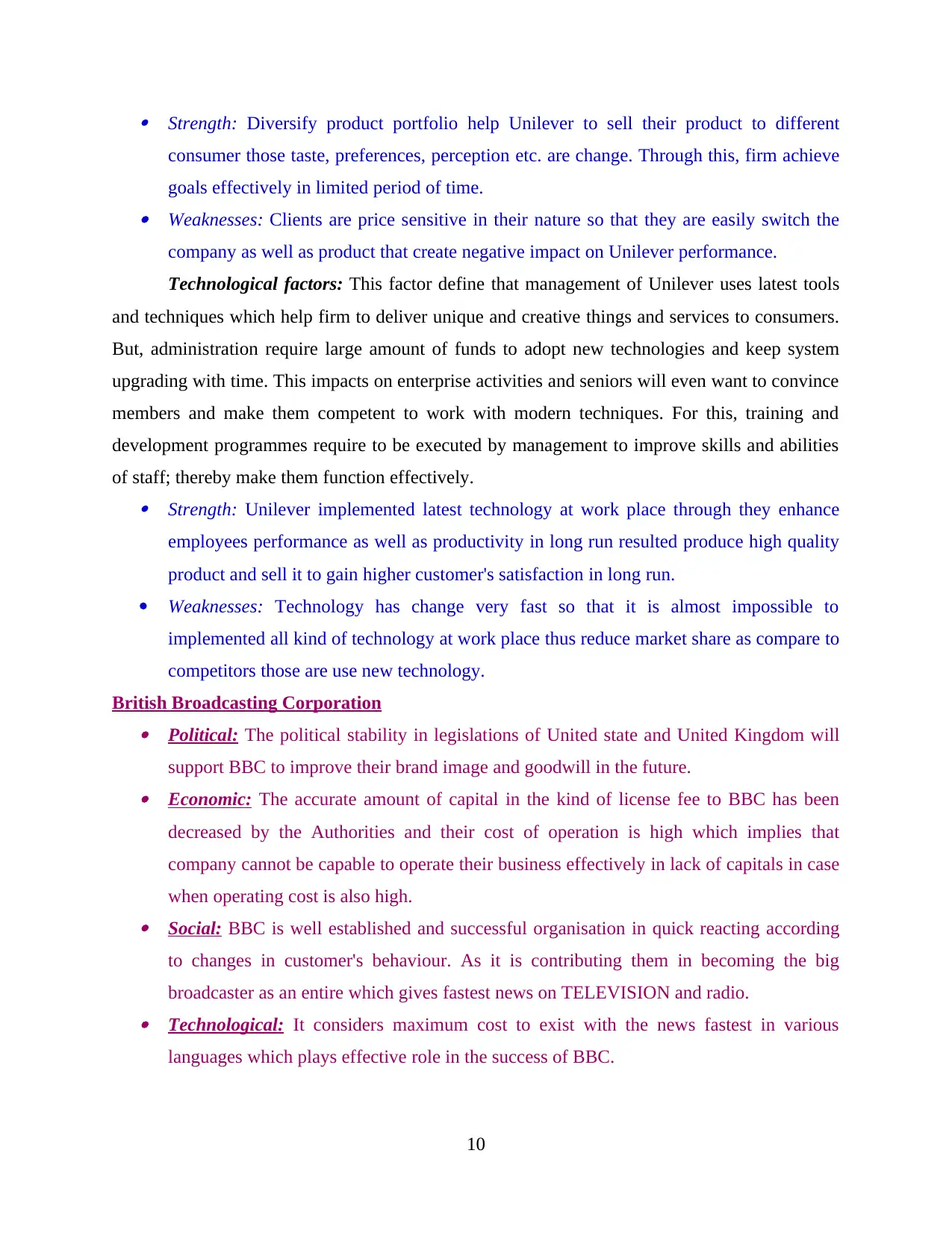
Strength: Diversify product portfolio help Unilever to sell their product to different
consumer those taste, preferences, perception etc. are change. Through this, firm achieve
goals effectively in limited period of time. Weaknesses: Clients are price sensitive in their nature so that they are easily switch the
company as well as product that create negative impact on Unilever performance.
Technological factors: This factor define that management of Unilever uses latest tools
and techniques which help firm to deliver unique and creative things and services to consumers.
But, administration require large amount of funds to adopt new technologies and keep system
upgrading with time. This impacts on enterprise activities and seniors will even want to convince
members and make them competent to work with modern techniques. For this, training and
development programmes require to be executed by management to improve skills and abilities
of staff; thereby make them function effectively. Strength: Unilever implemented latest technology at work place through they enhance
employees performance as well as productivity in long run resulted produce high quality
product and sell it to gain higher customer's satisfaction in long run.
Weaknesses: Technology has change very fast so that it is almost impossible to
implemented all kind of technology at work place thus reduce market share as compare to
competitors those are use new technology.
British Broadcasting Corporation Political: The political stability in legislations of United state and United Kingdom will
support BBC to improve their brand image and goodwill in the future. Economic: The accurate amount of capital in the kind of license fee to BBC has been
decreased by the Authorities and their cost of operation is high which implies that
company cannot be capable to operate their business effectively in lack of capitals in case
when operating cost is also high. Social: BBC is well established and successful organisation in quick reacting according
to changes in customer's behaviour. As it is contributing them in becoming the big
broadcaster as an entire which gives fastest news on TELEVISION and radio. Technological: It considers maximum cost to exist with the news fastest in various
languages which plays effective role in the success of BBC.
10
consumer those taste, preferences, perception etc. are change. Through this, firm achieve
goals effectively in limited period of time. Weaknesses: Clients are price sensitive in their nature so that they are easily switch the
company as well as product that create negative impact on Unilever performance.
Technological factors: This factor define that management of Unilever uses latest tools
and techniques which help firm to deliver unique and creative things and services to consumers.
But, administration require large amount of funds to adopt new technologies and keep system
upgrading with time. This impacts on enterprise activities and seniors will even want to convince
members and make them competent to work with modern techniques. For this, training and
development programmes require to be executed by management to improve skills and abilities
of staff; thereby make them function effectively. Strength: Unilever implemented latest technology at work place through they enhance
employees performance as well as productivity in long run resulted produce high quality
product and sell it to gain higher customer's satisfaction in long run.
Weaknesses: Technology has change very fast so that it is almost impossible to
implemented all kind of technology at work place thus reduce market share as compare to
competitors those are use new technology.
British Broadcasting Corporation Political: The political stability in legislations of United state and United Kingdom will
support BBC to improve their brand image and goodwill in the future. Economic: The accurate amount of capital in the kind of license fee to BBC has been
decreased by the Authorities and their cost of operation is high which implies that
company cannot be capable to operate their business effectively in lack of capitals in case
when operating cost is also high. Social: BBC is well established and successful organisation in quick reacting according
to changes in customer's behaviour. As it is contributing them in becoming the big
broadcaster as an entire which gives fastest news on TELEVISION and radio. Technological: It considers maximum cost to exist with the news fastest in various
languages which plays effective role in the success of BBC.
10
⊘ This is a preview!⊘
Do you want full access?
Subscribe today to unlock all pages.

Trusted by 1+ million students worldwide
1 out of 16
Related Documents
Your All-in-One AI-Powered Toolkit for Academic Success.
+13062052269
info@desklib.com
Available 24*7 on WhatsApp / Email
![[object Object]](/_next/static/media/star-bottom.7253800d.svg)
Unlock your academic potential
Copyright © 2020–2025 A2Z Services. All Rights Reserved. Developed and managed by ZUCOL.





